|
|
COMPETITION The Trident three-cylinder in the US |
|
|
|
COMPETITION The Trident three-cylinder in the US |
|
In the early 70s the trecilindri English, the Triumph Trident and BSA Rocket 3 sister, gather in the fields of major US race results. Both motorcycles won the most important trophies: the AMA's 1970 (Triumph Trident) and the Daytona 200 in 1971 (first place BSA Rocket 3 and the second step of the podium for the Triumph Trident in 1971).
The onset of the three English-cylinder in America bears the date of the Daytona 200 in March 1970. From 1970 to 1973 the overall balance of wins in the USA is a Grand National to head (Trident and Rocket 3), a Daytona 200 (Rocket 3 ) and, as regards the speed, six wins (5 for the Rocket 3 and one for the Trident).
Already in 1972 the British company significantly reduces investment and the three cylinders are no longer able to excel. The last participation in absolute was instead the Daytona 200 in 1974 (it was in the middle of two-stroke Yamaha TZ 700) with Tom Kidd and Percy Tait, both retired just before half. 1970
DAYTONA 200 MILES - March 1970 - THE TRIDENT 2ND PLACE WITH GENE ROMERO
One of the most important American events was definitely the famous Daytona 200, already won by the English house with the twins in 1962 (Don Burnett), in 1966 (Buddy Elmore) and finally in 1967 with Gary Nixon. Compared to the previous edition and thanks Agreement between the IMF and the AMA, Regulation dela allowing for the 1970 season in the Formula C 750 motorcycles derived series built at least 200 units, with an engine capacity up to 750cc and no other technical limits. Until the previous year, the maximum displacement was 500 cc for motorcycles with overhead valves, and could go up to 750cc engines with side valves, a rule clearly in favor of Harley-Davidson. The American branch, which in 1969 only for the brands BSA and Triumph, began to put pressure on the parent company that prepares the motorcycles fit for purpose. At that time the American market absorbed 75% of the production of the Triumph-BSA and participate in the Daytona 200 meant to reinforce the sporty image of the new three-cylinder without commit themselves to expensive to competition and maintaining a link, albeit subtle, with the production of the series. The new president of its US subsidiary, Peter Thornton, wants victories striking: " We have to dominate all the events of the AMA Grand National "Do you know the USA. It does allocate unflinchingly the pharaonic figure of $ 440,000, and instructed the head of the new Department Peter Colman American racing drivers to find him suitable. In November 1969 Meriden is created a special racing department unified (BSA-Triumph) led by Doug Hele with the task of preparing the bike for the Daytona 200 in March following. There are less than three months time and scarce resources should be optimized. The preparation of the Trident engine is under the supervision of Hele same, that of the three-cylinder Rocket 3 is headed by Jack Shemans, his confidant for many years and experienced engineer to Meriden since the late 60's. More or less the "recipe" processing is the same view of the close relationship between the two engines: new crankshaft, new pistons and new carburetors. The rated power was increased to 81 bhp at 8,250 rev / min (some source returns a value of 84 hp at 8500 rpm). The change of series four relations is replaced by a Quaife Competitive five reports. The lid of the distribution is shrunk to increase the bending angle. The three exhaust manifolds are united under the gearbox and the three-in-one ends with a silencer to a megaphone. The braking system uses the front of a drum of 250 mm dual cam Fountain racing four-jaw, while the rear is a single disk. The tank, glass fiber, has a capacity of 5 gallons (about 19 liters). For chassis instead, Doug Hele relies on the specialist Rob North that draws the famous double cradle tubular steel Reynolds 531. Regulation permissive effect for the new Formula 750 C allowed the use of lightweight frames and custom-built and, given the success of the twins with Rob North frames and brought in competition by Percy Tait, the English house confirms the collaboration with the specialist English North. The first approach with Rob North, which would have linked his name to the three-cylinder Daytona, took place at the end of 1968 was Percy Tait who turned to his friend to make a special frame for the Triumph twin engine semi-official use for national league matches. Paul Smart goes in the workshop of Rob North in an old cinema converted to a workshop. Here Rob begins to build the frame around the same Paul Smart sitting in the "race". The first double-cradle tubular steel Reynolds 531 for the Triple is ready in January 1970 and the Paul Smart to try the new bike in a minor event in the circuit "Crystal Palace" in London a path, now deceased, made the same name in the London area. Remember, Paul Smart, " The new prototype is loaded into a van driven by hired Doug Hele and a couple of mechanics. Hele knew every single little detail of the bike and I had confidence in him. Never showed his emotions but it was fully involved in this project. " For the shipment of Daytona to be put in six motorcycles (four and two Triumph Trident BSA Rocket 2), but in North are commissioned sixteen frames, all different from each other for dimensions and geometries in order to try to satisfy the needs of different riders. The versions for Trident and for Rocket differ only by the attacks of the engine. This first set of frames is known as "highboy" to differentiate them from the next series "lowboy" in 1971. Thanks to the new chassis Rob North "highboy" the engine is higher than 6 cm compared to the standard version, to the benefit of handling. It also provides more space for large tank capacity and greater rigidity to the complex. The structure, in tubes, was simple in its rationality: the upper tubes directly connecting the steering head with the point of the swing arm, while the other two tubes descendants formed the cradle. The rear part, in tubes of smaller diameter, served as a support for the seat and the upper attachment for the shock absorbers. Today, simple, thirty years ago, brilliant! It will be only the end of 1970 which debuts the new version called "Lowboy" is lower than the previous, adopt different welding process, has a different angle of the steering head and is more almost three ounces lighter. It will be used on the famous Trident "letterbox", and sisters Rocket 3, who trod the tracks until the withdrawal of racing. |
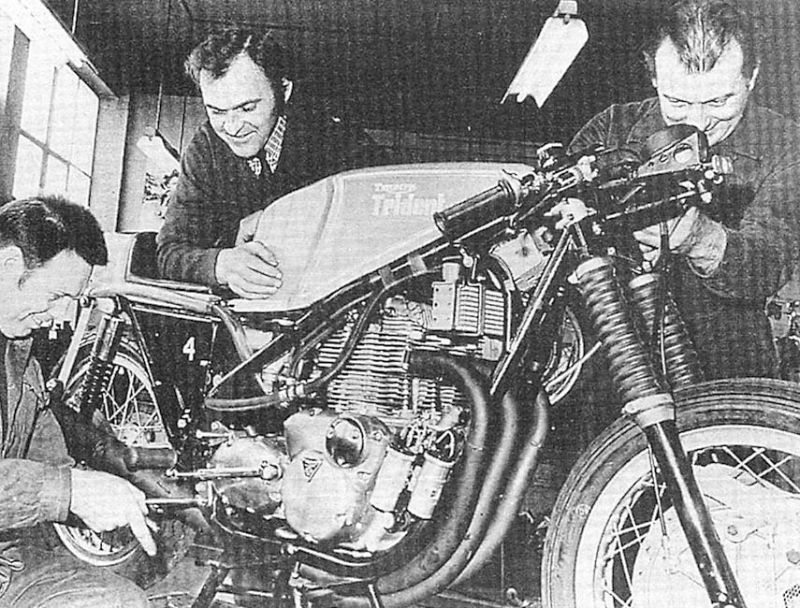 Percy Tait (center) in "racing team" Meriden along with the Trident version of the Daytona 200 in preparation. This is the only bike
assembled in Meriden for the Daytona 200. The other will be assembled directly in the US shortly before the competition. (source: Triumph - The Racing Story of Milk Walker) The few winter tests conducted in the English fog entrusted to Percy Tait, driver and tester of the House of Meriden. And 'he who gave the general guidelines for the development and work is progressing fairly quickly and without too much trouble. Unfortunately we do not take into account a factor that will prove decisive in Florida: the heat. Tait fact grinder km in England during the coldest months of the year, and in those conditions the motors do not have cooling problems, as it happens in Daytona in March. The fairing and the tail of the big bikes are made by the Research and Development Department Hall of Umberslade and finished after a series of tests in a wind tunnel made available by the Royal Air Force. The Rocket 3 and Trident intended to participate in the 1970 edition of the Daytona 200 are prepared in a hurry in the Department Races in Meriden, but they are not finished in time for shipping to the US. It was decided to send a container with all the necessary materials to complete the assembly of the bikes directly in the US. Even Daniel Fountain, which was to provide the brakes, is late with the delivery and must personally bring the latest brakes in the US, imbarcandoli as hand luggage on the plane! The container shipped from Meriden contains, in addition to motion to assemble, also ' only complete example that is used by the Trident Percy Tait for testing which will then be brought to the race by the same test. A week before the start of the tests, while the material is unpacked, a hard-working American employee discovers that the technical regulations of the Grand National AMA allows the use of special parts as long as they are regularly put on sale at dealers in the House. And this, of course, is not the case in exchange rates Quaife. To solve the problem, Doug Hele ship from England is a chest with 50 changes and a reprint the catalog of accessories and spare parts for the American market, by entering in the price list changes "implicated". 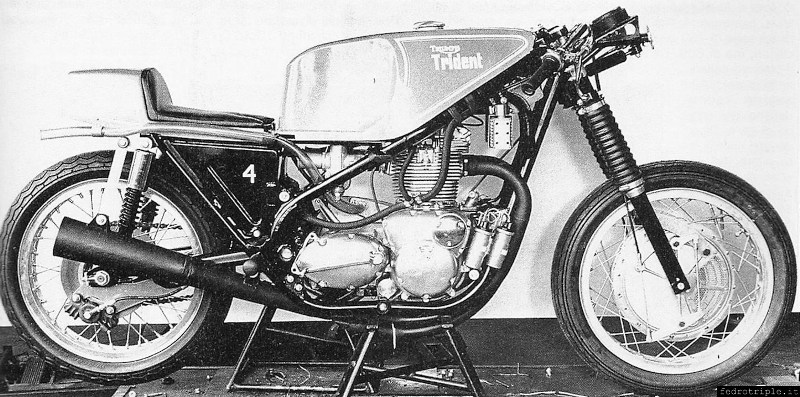 Trident 750: official photos of the version prepared for the 1970 Daytona 200 (the original lead in the race for Gary Nixon). Adding further uncertainty to the situation should also be remembered that this material is cleared through customs in New York on the day of 200 miles before an official of the AMA who then calls in Daytona to confirm the arrival of the goods. Doug Hele, who followed the away team, remember they were brought even the four-speed transmissions, to be used in the event of non-approval of the Quaife competition. Until then, then the participation of BSA and Triumph in the race is in doubt and time of the tests are valid, but "sub-judice". As you can imagine, the atmosphere in the pits so far is tense, because Doug Hele noticed that the men of the AMA do not treat everyone the same treatment. During the tests it occurs the spectacular fall of English Ralph Bryans, one of four Honda riders. In the collision against the asphalt of the CR750 is broken and the bike caught fire, revealing a particularly disturbing: the engine has a magnesium crankcase, then absolutely not standard, as well as discharges of titanium. The British are quick to point out, calling for an immediate check of the other three Honda entered in the race, but no commissioner lift a finger. The Daytona 200 of March 1970 marks the debut of the three cylinders in the British American ski speed. The show of force put on display in Florida in 1970 by BSA-Triumph Group is impressive and the six motion are handled by American and European riders, hired with no expense spared. There are four marked Triumph (Trident) and two are marked (BSA Rocket 3). To drive the Triumph are Gene Romero (# 3), Don Castro (# 81), Gary Nikon (# 9) and English Percy Tait (# 56). The team BSA instead of only two riders: Jim Rice and Mike Hailwood (# 50), which now has taken the automotive career, but returned to the one-off two wheels. Dick Mann, who normally runs with the BSA, is a rider capable of going strong in all specialties of the Grand Nation: Cross, Speed, Flat-track and even Regularity. At the end of 1969 Peter Thornton (large head of the American branch Triumph / BSA) believes Mann's now too old to be a tough race like the Daytona and lets him walk preferring young Jim Rice. It is a fatal mistake because Mann is hired by and with the new Honda CR750 won the race just before the two Triumph Romero and Castro! From the first laps at Daytona was clear that trecilindri were very successful. Gary Nixon so reminiscent of the early laps of the test: " The bike had radically changed the face and character (the previous year). So much power, but also a good shot from the engine that comes with a relationship in addition, could really give their best. While the chassis offering handling and stability. It also forgave some pilot error. In addition, the drum brakes Fountain were really the best I've ever tried. So much so that I wanted to use it the following season, while my teammates were gone by the records. Hele and the guys at Meriden had done a great job! The "triple" was almost a twin size and weight, but offered fantastically superior performance. Those bikes touched 265 km / h, they were much faster than anything else I've ever used in the race . " During the qualifying Gene Romero riding the Trident 750 is the fastest time at an average of over 253 km / h , followed by Mike Hailwood riding the BSA Rocket 3 to about 246 km / h. The third time is Gary Nixon always with the Trident. The English bikes scare the Americans so that from the very first evidence that disputed the week before the race, are exposed to claims against the British bikes. The HD team challenges such as the length and size of the tail of the three-cylinder engine that makes 200 revolutions per motor gain (equivalent to nearly 5 km / h in terms of speed). In Daytona protests is temporarily dismissed, but the following test circuit in Talladega, the AMA will force you to cut a couple of inches of the offending piece. 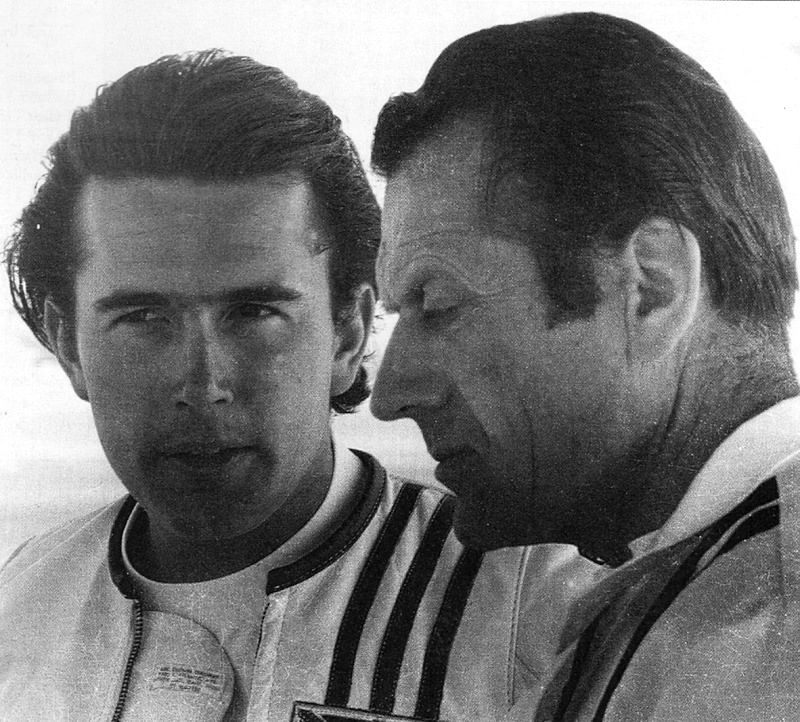
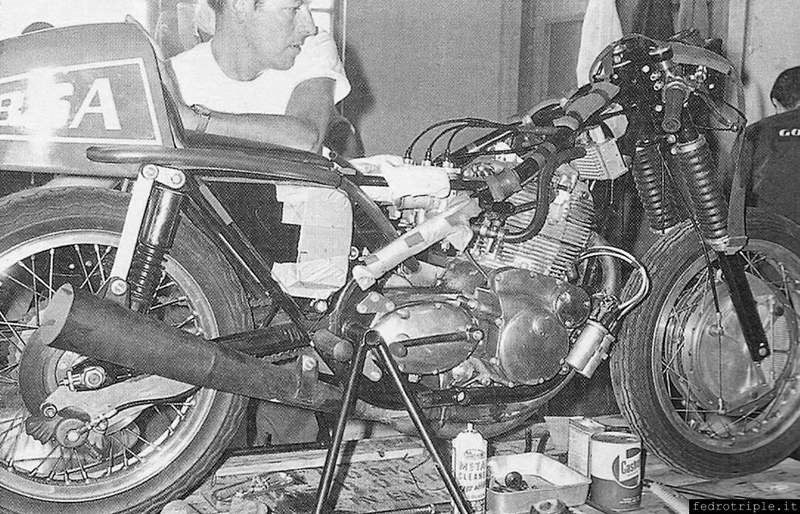
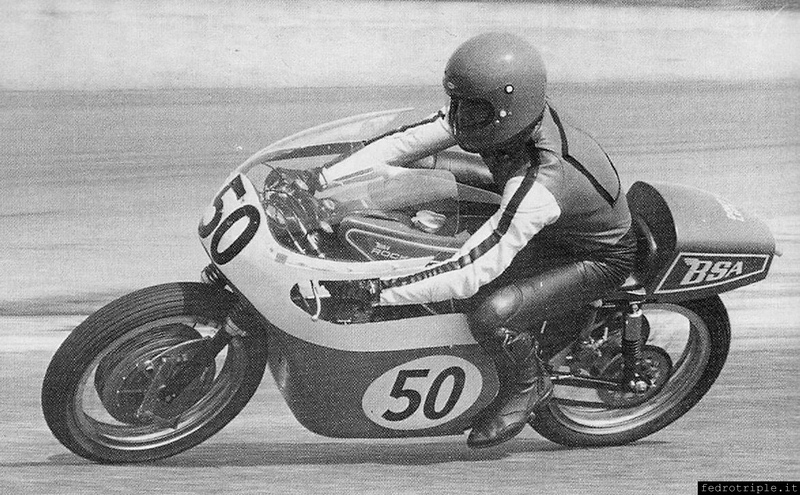
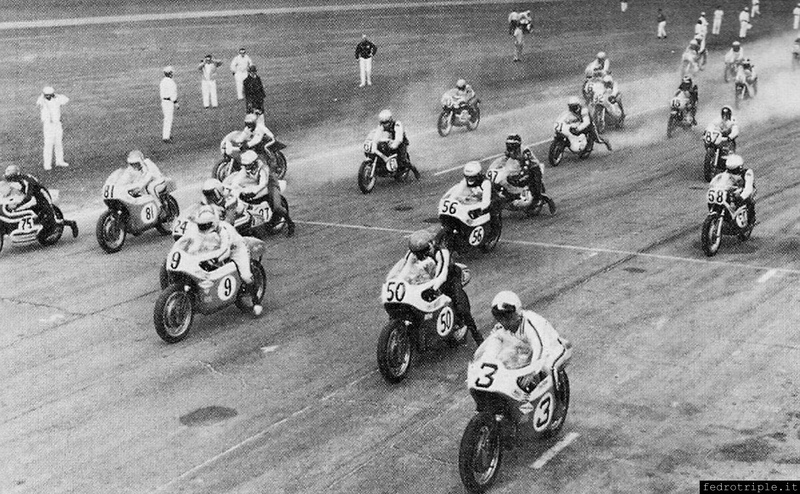
The first part of the race is a real no-holds-barred battle between Mann (Honda), Hailwood (BSA), Rayborn (Harley-Davidson), Grant (Suzuki) and Nixon (Triumph). Then the problems begin. The first is to abandon Rayborn with the twin HD zone, followed by Hailwood problems with the engine of his Rocket 3 (due to poor cooling), which, however, has the honor to hold the lead for several laps. Grant (Suzuki) is therefore in the lead, followed closely by Nixon (Triumph) and Mann (Honda) was a little more distant. The high consumption of the two-cylinder two-stroke Suzuki loose dry Grant along the way, so on the 28th lap Nixon remember riding the Trident 750, he finds himself in the head with a big lead. He would have kept you right here, if the 50th passage just three laps from the finish of the race, the engine of his Triumph could be found with the piston and the cylinder head out of commission for central heating! So he ended up Mann won the Honda 750 followed by Gene Romero, in just 10 seconds, riding the Trident # 3 who saved the British army from complete defeat. The third place is occupied by Don Castro riding the Trident # 81. However, it was a tough game, and came to an end only 16 competing against 98 drivers lined up on the starting line. 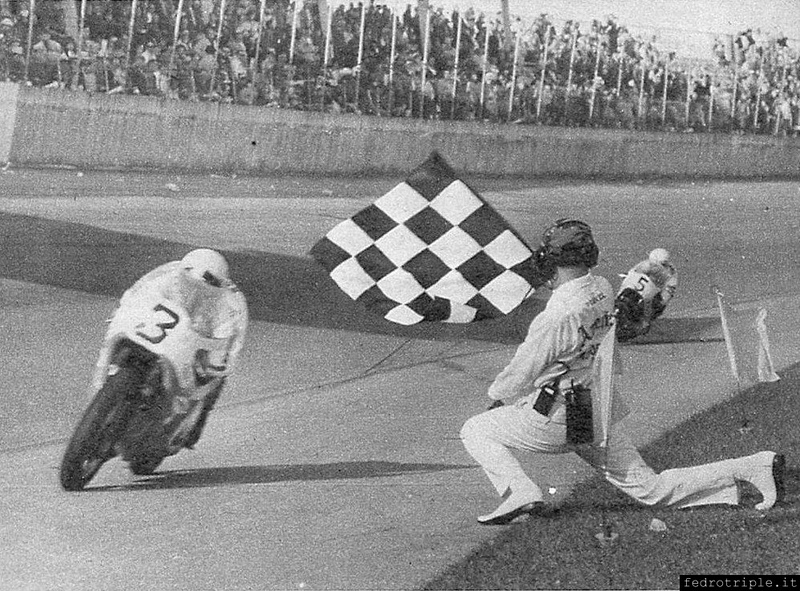 Gene Romero riding the Trident earns second place at the Daytona 200 in only 10 seconds behind the winner Dick Mann The test Tait, affected by his poor physical condition (injured in the arm) and gearbox problems, does not collect significant results. The pilot-reporter Tony Murphy had the chance to try the Trident officer Gene Romero reached the second step of the podium of the Daytona 200. He wrote (engine): " It 'delicious: the period of use is the largest of the motion of the championships for the motion of the derived series. No need to keep it close to the red zone, which begins 8,500 rpm, because already below the 5,000 push hard, and 6,000 up looks really sing. " Baptize "Daytona Triple" these three cylinders were of Cool motorcycle engine combined with powerful, yet usable, and Rob North frame which provided excellent dynamic characteristics. This combination will create a legend of racing for production-based series of the 70s. In March '70 Bert Hopwood had wanted to put into production the "Daytona Triple" and wrote a letter to that effect to the Board Triumph-BSA. It was not heard and the "Daytona Triple" never entered production. 1970 TRIUMPH TRIDENT SAMPLE AMA
The American AMA Championship continues with the second race at Talladega won by Dave Aldana riding the BSA Rocket 3 at Daytona while Hailwood used by Nixon with Trident retires for a fall. At the third meeting, on the demanding circuit of Loudon in New Hamsphire, Nixon finally able to bring victory to the Trident winning the race over a distance of 100 miles. The rest of the season will be a triumph motorcycles English not only won "The American Racing Championship "but all occupy the top five places in the rankings. And 'thanks to Gene Romero Triumph won the last time the Grand National in 1970, beating Jim Rice riding the BSA. At the third last round of Sacramento, a one mile oval, the BSA-coupled Rice was presented at the top (534 points versus 521), and had been convinced by the boss of the BSA Group in the USA Peter Thorton to use a special Rocket 3 Dirt-track, fast but uncontrollable. The result was a terrifying flight into the barriers during the first heat of qualifying. Stoically Rice qualified for the final, where he collected a fifteenth insufficient to maintain the lead. In the two subsequent tests, at Ascot and Oklahoma City Romero won again making sure the league. 1971 DAYTONA 200 MILES - March 14, 1971: THE TRIUMPH OF ENGLISH
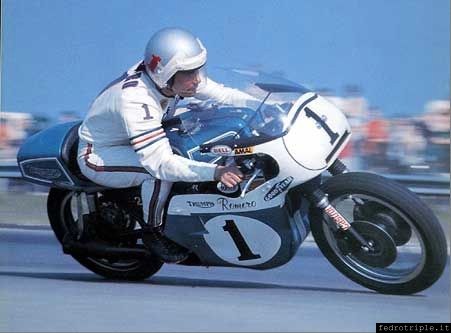 1971 - Gene Romero riding the Trident during the Daytona 200 Miles: 2nd at the finish line The goal for 1971 is to win the Daytona 200. The eventual success at Daytona is not just sports but mainly commercial. Peter Thornton (large head of the American branch Triumph / BSA) does not want to repeat the mistake of the previous year and sets two objectives: to put under contract Dick Mann (the winner in 1970) and increase the number of bikes to be deployed in Daytona and in the remaining trials for the Grand National. All of course with no expense spared ... the use of manpower and resources is impressive. To take care of the negotiations with Dick Mann Pete Colman, Director sports teams BSA / Triumph in the US, putting on the table an offer impossible to refuse: the contract rider, guaranteed to have a spot on the team in all speed tests of the Grand Nation and a large stock of spare parts and special parts to deal with the season at the top of the Flat-track. So, for those strange coincidences of life, the pilot of Richmond became at age 37 the top riders of the BSA Grand National championship in the US, where only a year earlier had been rejected because it was considered too mature. Mann repays the trust placed in the best possible way by winning the Daytona 200 and the Grand National. That of 1971 is its eighteenth season of racing, but the deal with the enthusiasm of a newcomer: the championship if he has already won in the 1963, then the experience necessary to defend themselves from the onslaught of young lions without worrying about the age difference. As just one example, his teammate Dave Aldana was born in 1962, the same year the old Dick made his debut in the Dirt-Track with a BSA Gold Star. Despite his age, the undertaking of pilot Richmond is remarkable, such as the BSA Group on the other hand. In Daytona motorcycles are recognized as ten (five and five Triumph BSA) and the costs are largely borne by the importer the US, but it does not seem to care too much. In addition to the six specimens that were assembled during the year 1970, in the workshops of Meriden, four new units. For the BSA is still Mike Hailwood (with an expensive token presence) and four Americans: Don Emde, Jim Rice, Dave Aldana and the aforementioned Dick Mann. Hailwood is hired by the BSA as more superstars to attract the public and the press as the first guide: from the commercial point of view it is important that the winner is American. 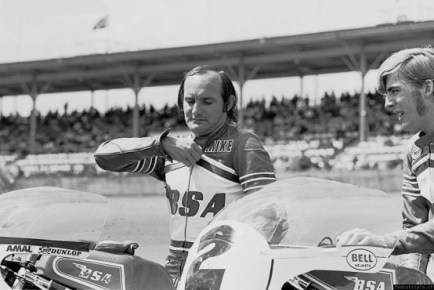 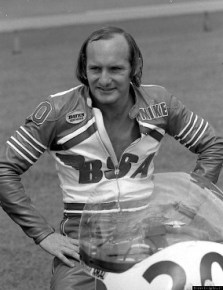 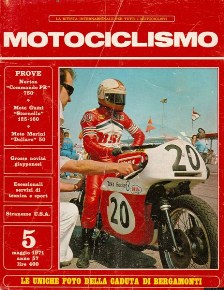 200 Miles Daytona 1971 Mike "The Bike" riding the BSA Rocket 3. On the right the cover of Motorcycle May 1971 For the Triumph Meriden instead compete confirmed the Gene Romero (# 1), Don Castro (# 5) and Gary Nixon (# 10) plus newcomers Paul Smart (# 12) (instead of Percy Tait) and Tim Rockwood ( # 9) only with the brake drum. Gary Nixon took part in the race even if it is not physically fit: a few days before the race it will break a leg! The bikes, go back to England at the end of 1970, are reviewed and updated. The most important change concerns the frame of some motorcycles, four of them, intended to Romero, Smart, Mann and Hailwood in fact benefit from a new double cradle designed by Rob North. Upon instructions from Percy Tait, North down the steerer tube of two inches, increased by two degrees the angle (now 28 °) and shortens the fork legs. The motor is moved forward and upward by about 40 mm to increase the load on the front axle. This change reduced the wheelbase of the bike that North restores simply lengthening the swingarm. The new frames are baptized "lowboy". 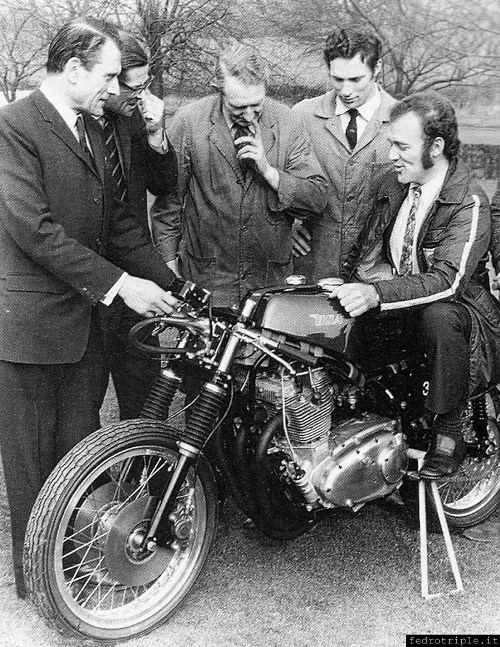 February 1971 - Surrounded by Hele and some engineers of the racing department, the pilot Paul Smart takes measurements of a Rocket 3. Daytona, however, use a Triumph Trident. (photo Motorcycling Period) The plates of the fork are reconstructed using a tubular brazed and adopting a distance between the stems greater than the original plates. In this way it is possible to mount a braking system constituted by two discs of 250 mm diameter braked by grippers Lockheed racing. Regarding the material, Rob North used the T45 tubes of Accles & Pollock judged, like the other British bike maker, best of Reynolds 531, mainly for their superior toughness. The hull for 1971, which was built in three parts, is optimized in order to increase the aerodynamic penetration and at the same time improve the cooling of the engine. A new front air intake, the famous "letter box", allowing the passage of air to the oil cooler mounted in the new raised position. Another change, as anticipated, is the adoption of the braking Lockheed ( 256mm disc and single-piston calipers) full disk, rather than mixed disc / drum as the previous year. With this change, the English are the first three-cylinder race bikes in the world to adopt such a solution. Small improvements were also made to the engine that goes from 81CV 84CV at 8250 rpm at 8,500 rpm with a little top speed clocked at Daytona equal to 273 km / h! The tank of the British motorcycle MY1971 has two caps for refueling. As explained by the Dough in a Hele interview '71, the second cap is simply to let the air out during the fast filling: 6 to 8 seconds to fully complete! Also because of the withdrawal of Honda, the performance of Harley Davidson and the unreliability of Kawasaki and Suzuki two-stroke, the evidence in the tri-oval Florida turns into an unprecedented success. The Honda and Yamaha are on the grid, but only in private homes and not supported by the official. 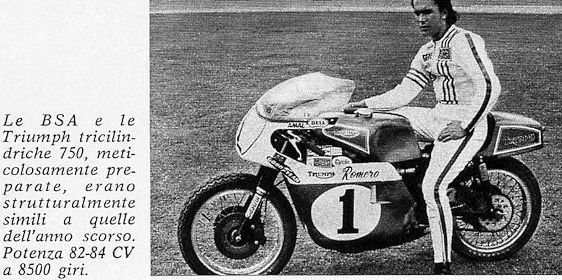
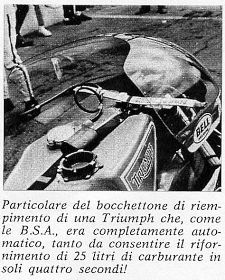 Gene Romero and particular reservoir Triumph Trident (Vintage Motorcycle Racing Photos) 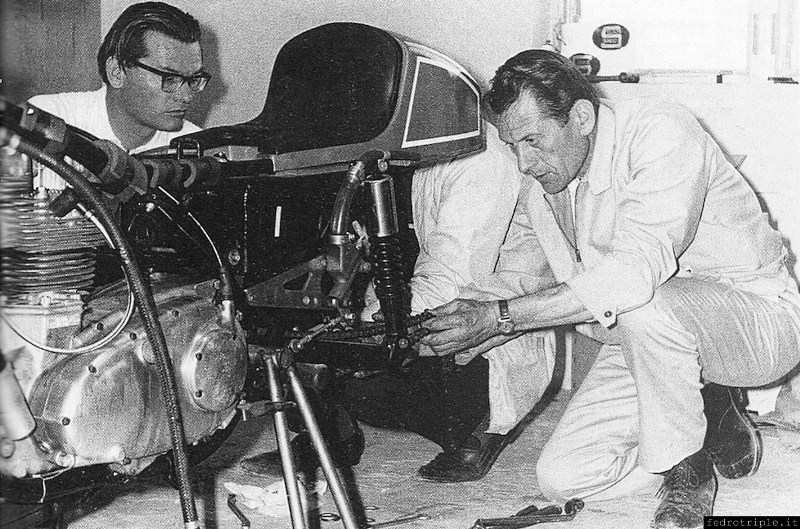 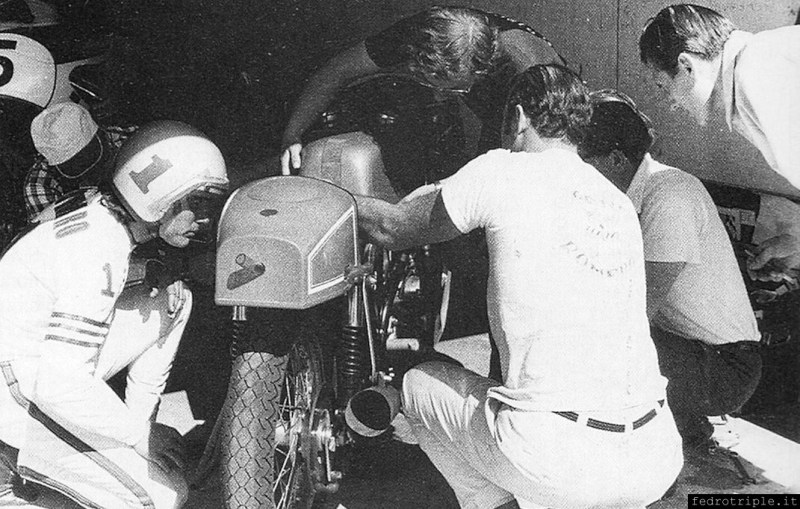 1971, the designer Doug Hele following work on the Trident Gene Romero repeat the result in 1970, finishing in second place. (Photo Vintage Motorcycle) 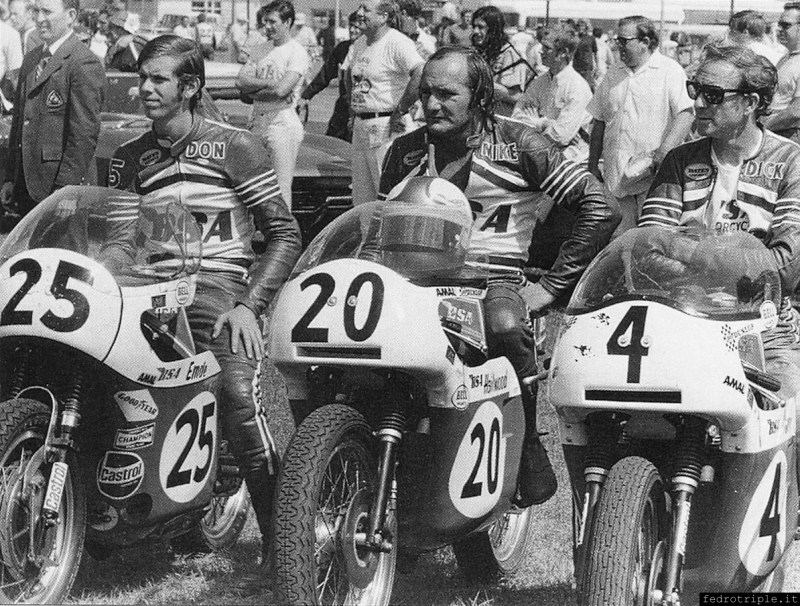 Souvenir photo just before the start of the race (from left to right): Sun Emde, Mike Hailwood and Dick Mann (the winner) riding the Rocket 3. (Photo Motorcycle Vintage) Motorcycling from April 1971: "The first stage of the race is something impressive and very dangerous because the over one hundred runners are all still contending with even ten centimeters of each curve. It 'was in the first part of the contest confusissima who died on the twenty-American Bradley Kawasaki crashed in the first corner after the finish line. Many other falls and several wounded, all rescued promptly exceptional service ambulance. Openly declare the professional runners to fear this initial brawl, and then even if strong starting position in the first bed, fast acceleration of the possibilities of their machines and their experience, they are able to keep as much out of the fray of the less experienced, motivated all from an extremely strong courage and enthusiasm. The race was very tight and it shows throughout the rest of the new record distance of 53 laps (104.737 miles against 102.697 miles last year), made last year by thirty-seven Mann Honda official. Hailwood was fantastic despite the long absence from the race track. He says unfortunately that is not going to meet the Grand Prix, as he almost two years of operation and would not want to see no longer the Hailwood before. For our part, we say it is always great and enough little riaffiatamento however necessary, as shown by the fall accorsagli in the first trials. Another good pilot pear we could not evaluate it with Cal Rayborn Harley-Davidson already in trouble from the first revolutions for the gearbox. Of the drivers who well knows the Italian public, and Finndlay include Molloy, both of Kawasaki, which withdrew all'imbiellaggio big trouble. Carruthers is instead finished tenth after being in fifth place during the first hundred miles on his Yamaha. Suzuki disappointing that despite the great organization and the five cars at the start did not finish the test for various problems ranging from the hole in pistione, the change stuck to a tendency to "tighten" the pistons. This year they were not allowed tanks capacity of more than 5 gallons (about 19 liters). BSA and Triumph made a single supply without shutting down the engine (as was required last year), while Kawasaki have had to stop twice. The British cars had an additional automatic nozzle on the tank so they could cram 25 gallons of fuel in just 4 seconds! At the "200 Miles", which took place on a beautiful sunny day, I interventui 42,500 spectators. " 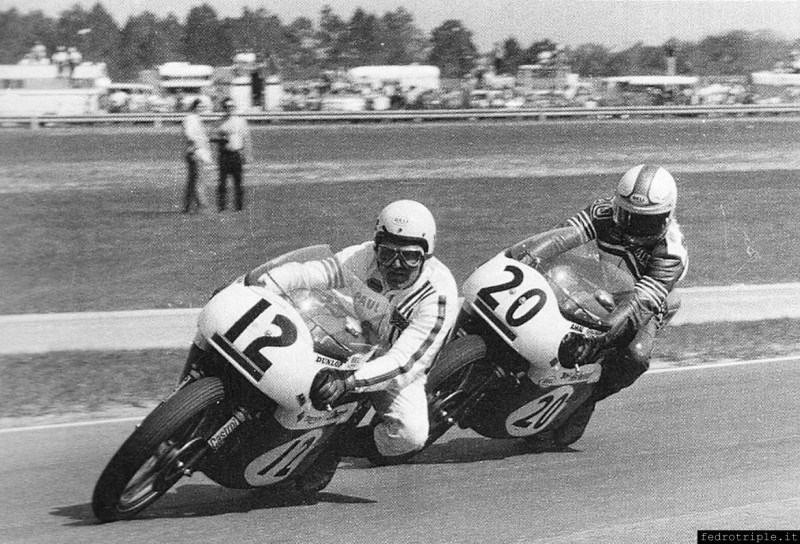 Duel between the sisters BSA and Triumph designed by Hele: the number 12 Paul Smart with the Trident before Mike Hailwood riding the Rocket 3 (Vintage Motorcycle Racing Photos) 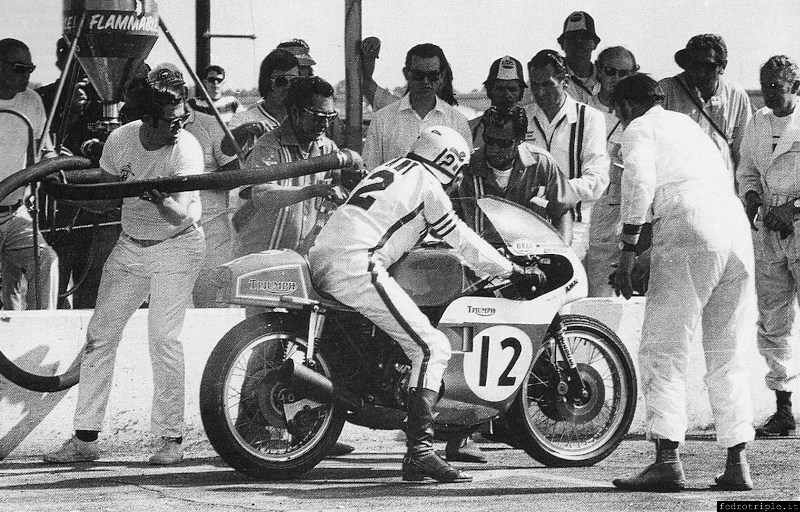 Paul Smart during refueling at the Daytona 200 in 1971. Doug Hele's recognizable by the white suit and black stripes vertificali. (Photo Vintage Motorcycle) 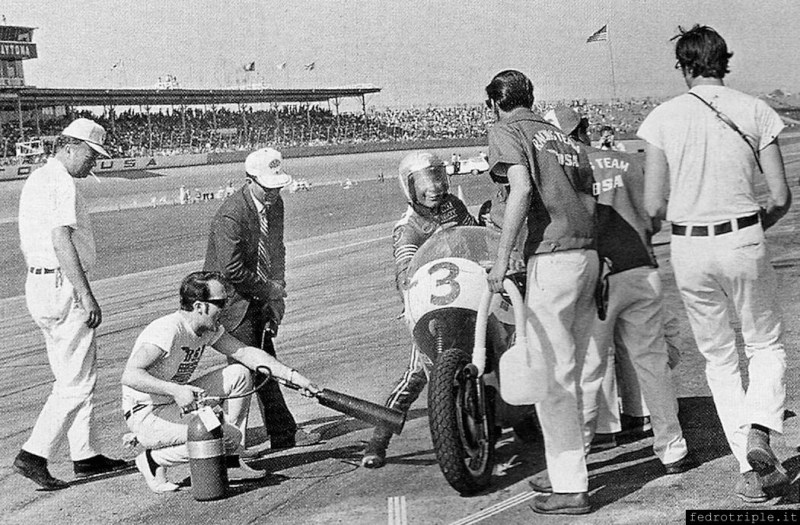 Dave Aldana during refueling at the Daytona 200 in 1971. (Photo Motorcycle Vintage) 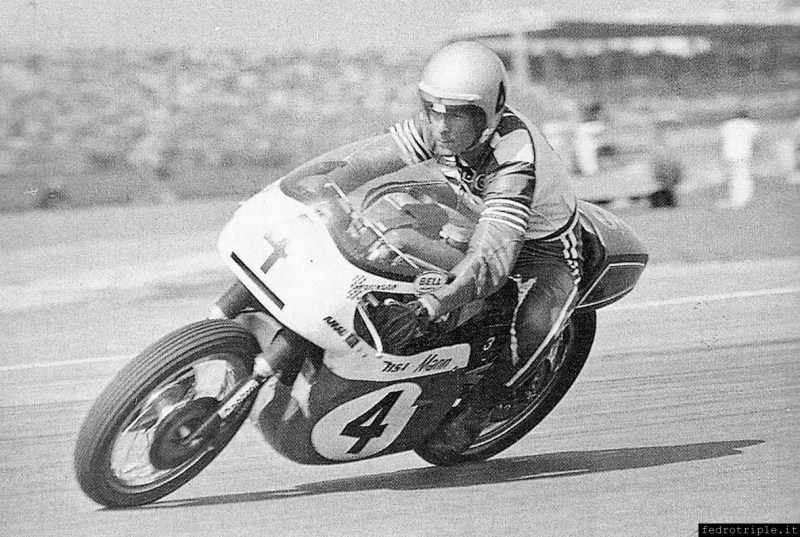 The winner Dick Mann riding the BSA Rocket 3 (photo Motorcycle Vintage) Paul Smart moves into top spot on lap five but was subsequently overtaken by Mike Hailwood keeping the lead until lap 14 when he is forced to retire due to a broken valve. At this point the Triple maintain the top five of the competition with Paul Smart in the lead until lap 41 when you have to stop to replace a candle and was forced to retire with a piston laundry. The winner Dick Mann Rocket 3, in front of Romero and Emde, the stratospheric average of 168,251 km / h, which will be the highest average ever achieved on the old route before entering in 1973 at the entrance of the second variant of the banked curve. Final standings: 1. Dick Mann (BSA 750) 53 laps in 1h54'55 "at an average of 168.521 km / h (new record), 2. Gene Romero (Triumph 750), 3. Don Emde (BSA 750), 4. Roger Reiman (Harley-Davidson 750 ) 5. Jim Odom (Yamaha) 6. Chuck Palmgren (Yamaha 350), 7. Jess Thomas (Triumph 750) 8. Tom Rockwood (Triumph 750) 9. Dave Smith (Kawasaki) 10. Kel Carruthers ( Yamaha) ... followed by others. 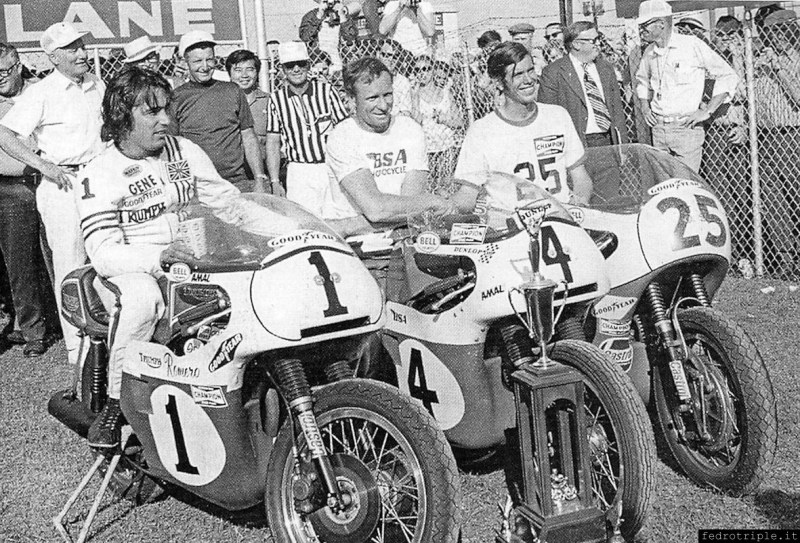 The podium of the 1971 Daytona 200: 1 Dick Mann (BSA Rocket 3) in the middle, 2nd Gene Romero (Triumph Trident) to the left and 3rd Sun Emde leading into the race, the BSA Rocket 3, 1970 (hull without "letterboxed" and Fontana front brake drum) (Vintage Motorcycle Racing Photos) The BSA Rocket 3 used by Mike Hailwood Edition 1971 Daytona 200 was destroyed in the fire at the National Motorcycle Museum in Birmingam in September 2003 and has been replaced by an exact copy built around a few pieces survived the flames. Below are some photos taken from carry-Vintage Motorcycle Racing (Feb 2006) portraying a true copy of the same bike built by Domenico Pettinari together with the original bike photographed at Daytona in 1971: 1971 AMA Championship After the race at Daytona, Dick Mann BSA and win the other two tests of speed (Kent and Pocono) and finish in second place on two other occasions (Road Atlanta and Talladega), markers which combined with results obtained in the Flat-track, allow the American rider to win the AMA Grand National Championship title. The second, third and fourth place in the league are occupied by riders with tricilindriche English: an unforgettable year!
The Big Race - 250 Miles of Ontario (California) - October 1971 - 1 BSA Cooper and then another triple
Towards the end of 1971, the situation of the group Triumph-BSA is disastrous and therefore the commitment to competition is reduced. However, on the occasion of "The Big Race" Doug Hele ago to prepare two special bike even more powerful and faster. This event was in fact considered strategic for the California market. "The Big Race" is the name of the last round of the AMA in 1971 is held at the brand new circuit "Ontario Motor Speedway" finished last year. Just a few miles from Los Angeles (California), the new track is 5 km long and has twenty curved. As mentioned Doug Hele and the Triumph racing division is developing two new trecilindri: a BSA with the brand and is headed by John Cooper and the second is marked Triumph and is led by Gary Nixon for the last time brought out the Trident. Paul Smart, despite the many successes achieved in racing circuits lose their first British rider team in favor of Cooper, in at the " Race of the Year "in dispitata Mellory Park a few months ago, won the race against G Jacomo Agostini and his MV Agusta. Then fly from England John Cooper, Doug Hele and two mechanics in addition, of course, the two motorcycles. The race is divided into two heats to 125 miles each with a break of 45 minutes between heats and the next. In the first heat with Nixon Trident is imposed by the authorities, far ahead of Yvon du Hamel on the Kawasaki 500 and John Cooper with the BSA. At the start of the second heat Nixon and Cooper take the lead and begin to remove the other 41 competitors. As Gary began dubbing, one of the pilots in the rear engine broke and drowns the asphalt oil. Nixon Trident Grand Suzuki, Mann and Aldana with the BSA are victims of the oil and glide to the ground, fortunately without serious consequences. Nixon, after returning to the pits to straighten the handlebars and footpegs, finishes the race in 12th place. It was the last race of Nixon aboard the Trident. Meanwhile in the lead followed by Port Cooper Gene Romero with the Trident. Romero takes the lead from lap 14 until 21 minutes in when you have to withdraw due to a problem with the throttle cable. Then comment Carruthers with Yamaha 350 until two laps to go. The race seems over, Carruthers relieves tension and hesitates over the last few overs. John Cooper, seeing a chance, fully open the throttle and runs the last lap at 9,500 rpm (1000 rpm over the red zone). The trecilindri screams, but resists, and Cooper won the race by a whisker! The fastest lap of the race goes instead to Gary Nixon aboard the Trident is scoring an average of 145.68 km / h. Cooper also won the highest prize paid for a street race: more than 60,000,000 pounds. Ironically the Rocket 3 Cooper, the latest version of the English trecilindri with the latest intelligence developments of Hele, was bought by Californian Bob Bailey with the rules of the competition that allows anyone to buy the motorcycle won at the price of $ 2,500 as long as you deliver the check within thirty minutes after the end of the race. 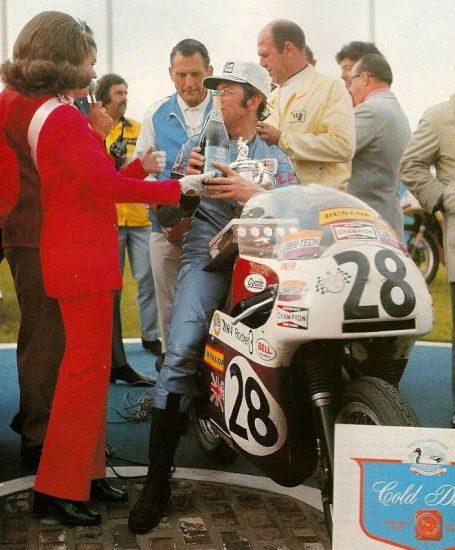 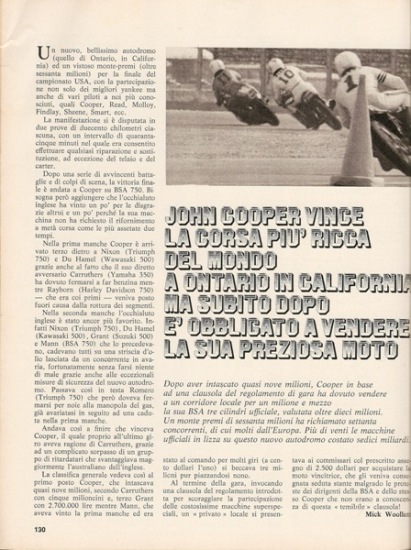 1971 - John Cooper, riding the Rocket 3 is awarded for first place just earned. Behind the designer Doug Hele The Rocket Cooper and Trident Nixon, the latest version of the Triple English, have changed the clutch that allows you to mount the engine in line with the chassis. Thanks to this little repositioning improves handling especially in fast corners right. The Trident Nixon is the same one used by Paul Smart with which he obtained the records in the circuits of Silverstone, Snetterton and Oulton Park in the space of eight days in late August. Sources within the racing department confirmed a power 86CV around for a weight of 158.8 kg. A few days later success in California (Ontario October 1971), the FIM gives the green light to the Formula 750 class that assumes the status of a world championship. The class, organized and set up associations AMA (American) and ACU (English), admits motorcycles with a cylinder capacity between 251 and 750 cc in the lane at least 200 units produced. The frame, fork, wheels and brakes must be approved by the manufacturer of the motorcycle. The regulation also requires 200 miles as the maximum length of the race to avoid hazards due to tire wear. 1972
During the meeting of the Board Triumph-BSA held in December 1971, in which we discuss the budget to be allocated for the competitions of 1972, Doug Hele says that it will be impossible to beat the Yamaha GP recognized American Grand National even having a budget twice the 1971 season (cost over a million dollars).
The group marketing manager, Peter Deverall, announced before Christmas '71 that the 1972 season will reduce the number of riders supported by the English house. It 's the end of the successes of the British group competitions (except for the interlude of the Italian Koelliker Racing Team). Daytona 200 Miles - March 1972 - 4th Dick Mann - Rocket 3
The first crackdown is seen at the Daytona 200, which traditionally opens the hostilities in America. Squad BSA and Triumph of the past years is nowhere: there are only Dick Mann (AMA champion 1971) with the bike in the previous year and two Triumph Trident entrusted to Gene Romero and the young Gary Scott, hired at virtually no cost zero. The carefree air of the previous years has given way to a grim atmosphere. There are a few mechanics, Doug Hele has been in England and Peter Thronton there is no trace. In the middle of a pack of 350 Yamaha two-stroke, three-cylinder British suddenly appear aged and with no chance to do well. In fact, Romero and Scott immediately pull the oars, preferring not to risk it. Dick Mann on the other hand is committed to the extreme, honoring the way his contract rider. It 's just because of him and if the BSA Rocket 3 at Daytona Group in 1972 does not lose face. During the tests, the pilot of Richmond suffers terribly, to the point that he can not describe his bike in the first group of 30 starters, but despite starting at the back the old lion will not give up. Thanks to its experience and taking advantage of the lower power consumption of the Rocket 3, Mann manages to finish in fourth place, despite the latter part of the race the bike suffers from power problems. The proof of Daytona unfortunately anticipates a season fraught with difficulties, considering that Dick Mann is unable to get on the podium in any of the tests of speed of the Grand National and his only victory achieved in a test of flat-track in Illinois. 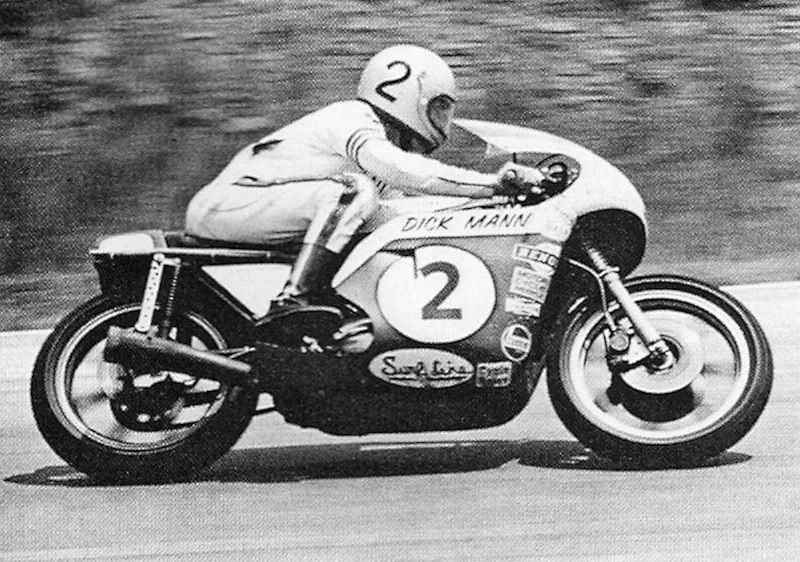 1972 - Dick Mann riding the Rocket 3 official at the Daytona 200. 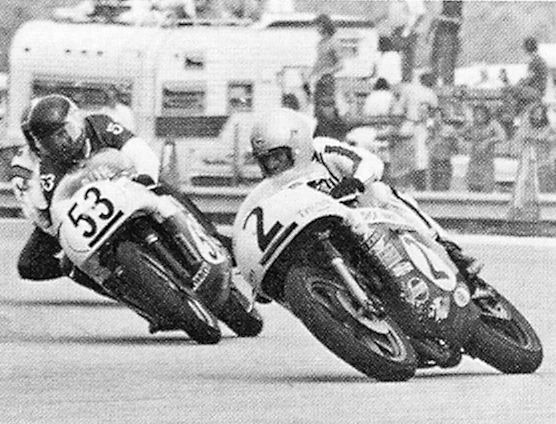 Dick Mann (No. 2) and a private Trident made with a replica chassis built by Rob North 1972 AMA Championship
The pair of Triumph riders concludes the second (Romero) and third (Scott) place the AMA Grand National Champion Ship, mainly due to the placings in the flat-track. while Dick Mann, and the Rocket 3, are sixth in the standings. At year end, there is an air of demobilization: Birmingham motorcycle production ends after the summer and for the future is marked BSA brand. Dick Mann is still confirmed as captain of the American team at the Transatlantic Trophy. Since 1972 the Rob North "Lowboy" are replicated on license from a small California-based company and offered for sale to private teams running with Triumph and BSA. Most of these frames are actually used in flat-track as the two-stroke motorcycles quickly become queens in the speed events. 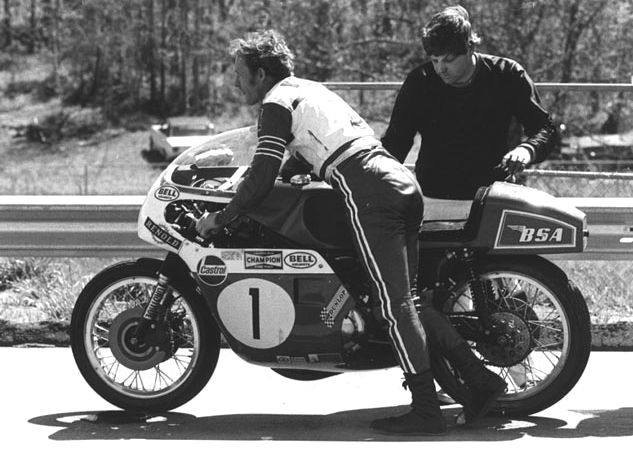 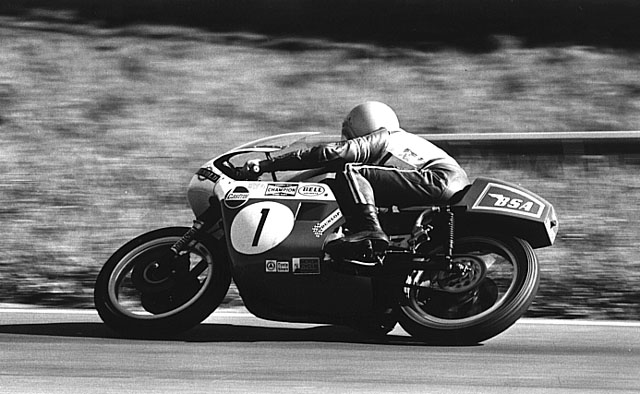 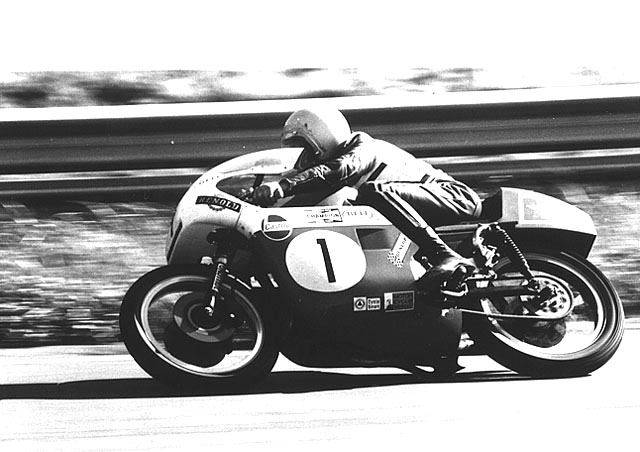 1972 - Dick Mann in action with the BSA Rocket 3 at Atlanta 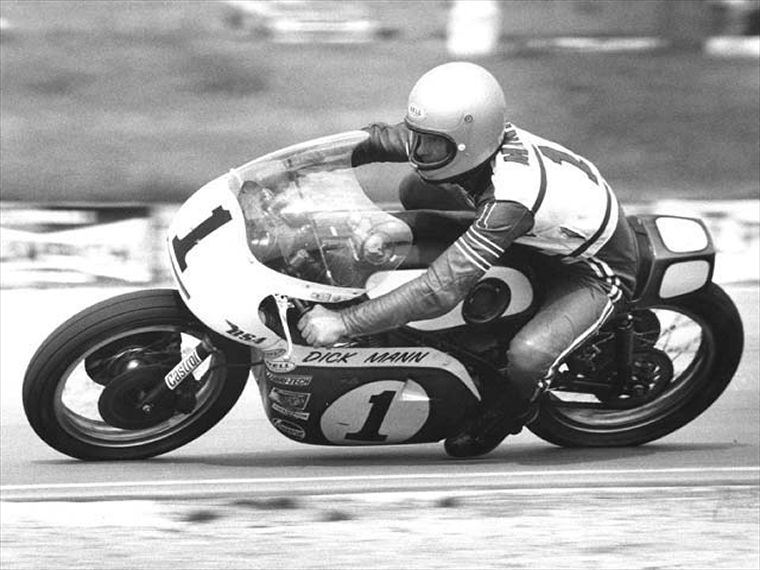 in 1972 - Dick Mann in action with the BSA Rocket 3 1973
The pilot Dick Mann, the age of 40, is determined to bow out, except that receives the latest offering to compete even in 1973 with the three-cylinder British. Of the glories of just two years before there is no trace, since the season is dealt with on a shoestring budget and with a single pilot, Dick Mann in fact. The choice of the motion is required because there is no longer the brand BSA, you should use one of the latest examples of the Trident remained in the US. Mann, however, is opposed to this decision, claims to be better on his Rocket 3 and is convinced he can still tell her, at least in some tracks. After a brief consultation is satisfied, but his bike is repainted with the colors Triumph and entered the league as Trident and not as a Rocket 3. A choice that has the flavor of the joke for most titles among the three cylinders of the BSA Group, unfortunately destined to not give any results, because in the forest of two-stroke motorcycles crowding the AMA dl 1973 (in addition to the Yamaha TZ there are also H2R Kawasaki and Suzuki TR750), the old and noble three-cylinder is no longer able to emerge. Notice in the picture above (p. 132 ME February 2006) alloy wheels. The second Trident (# 53) is that of the private Bob Bailey, made with one of the frames of the small number of "replica" built by Rob North 1974
The last-ever participation of the Trident on US soil was instead the Daytona 200 in 1974 (it was in the middle of two-stroke Yamaha TZ 700) with Tom Kidd and Percy Tait. Unfortunately, both will retire just before half. |
GO TO PAGE INDEX TRIDENT COMPETITION